BIOL 3340 FINAL EXAM PROMPTS
1/15
There's no tags or description
Looks like no tags are added yet.
Name | Mastery | Learn | Test | Matching | Spaced |
|---|
No study sessions yet.
16 Terms
Know the four Koch’s Postulates. Be able to describe each and what experiment was tied to each postulate. Also think of what limitations are involved with each postulate.
Koch’s postulates are criteria used to link a microorganism to a disease.
First, the microbe must be present in all cases of the disease but not in healthy individuals.
Second, it must be isolated and grown in pure culture.
Third, it should cause the same disease when introduced into a healthy host.
Finally, it must be re-isolated from the newly diseased host. Limitations include pathogens that can’t be cultured or that cause different effects in model organisms
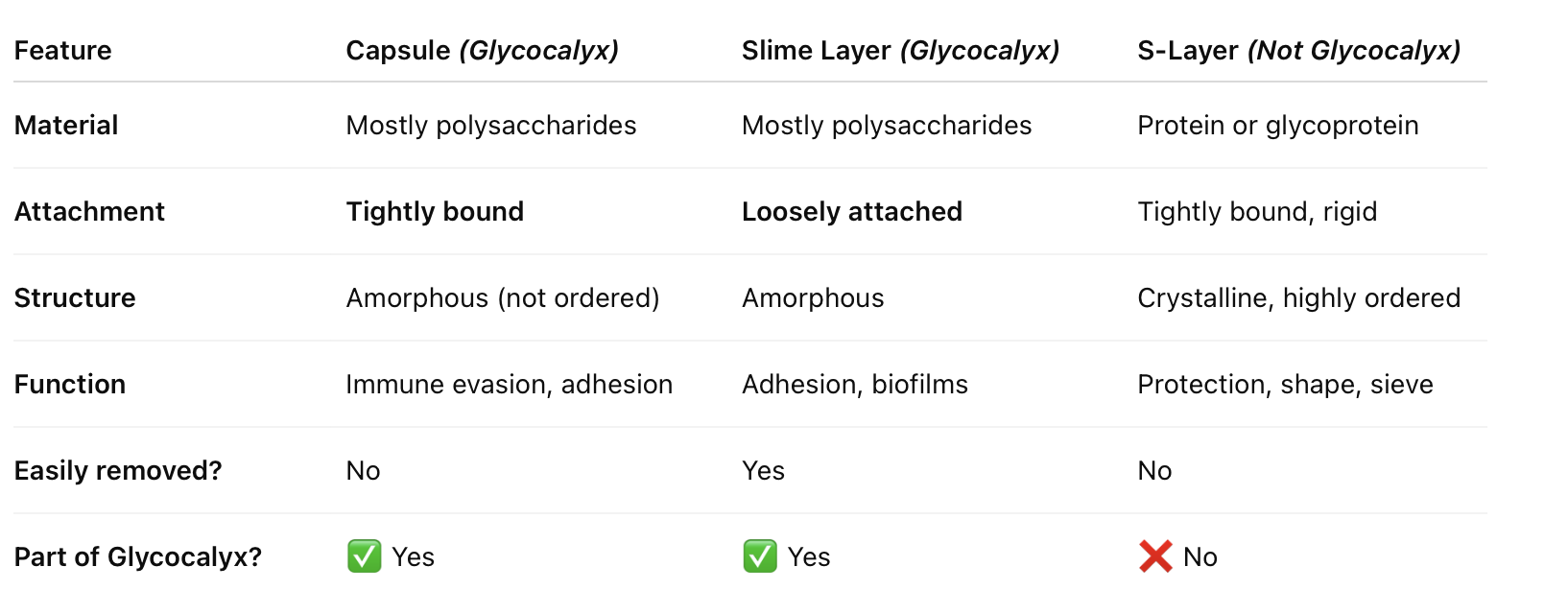
Know the difference between a capsule and a slime layer along with the term glycocalyx and how does it relate to capsules and slime layers.
The glycocalyx refers to extracellular material surrounding bacterial cells, which includes capsules and slime layers.
Capsules are well-organized, tightly attached to the cell wall, and protect against phagocytosis.
Slime layers are more diffuse and loosely attached, aiding in surface attachment and biofilm formation.
Both play roles in immune evasion and environmental protection
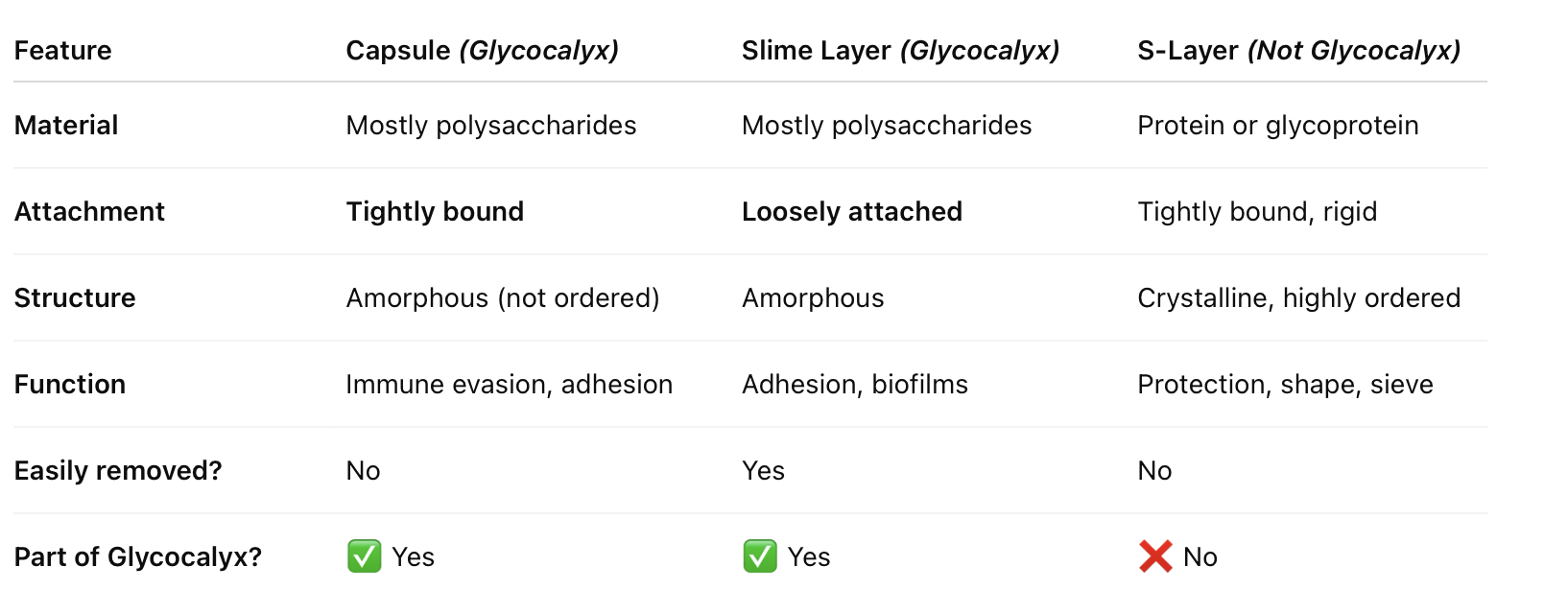
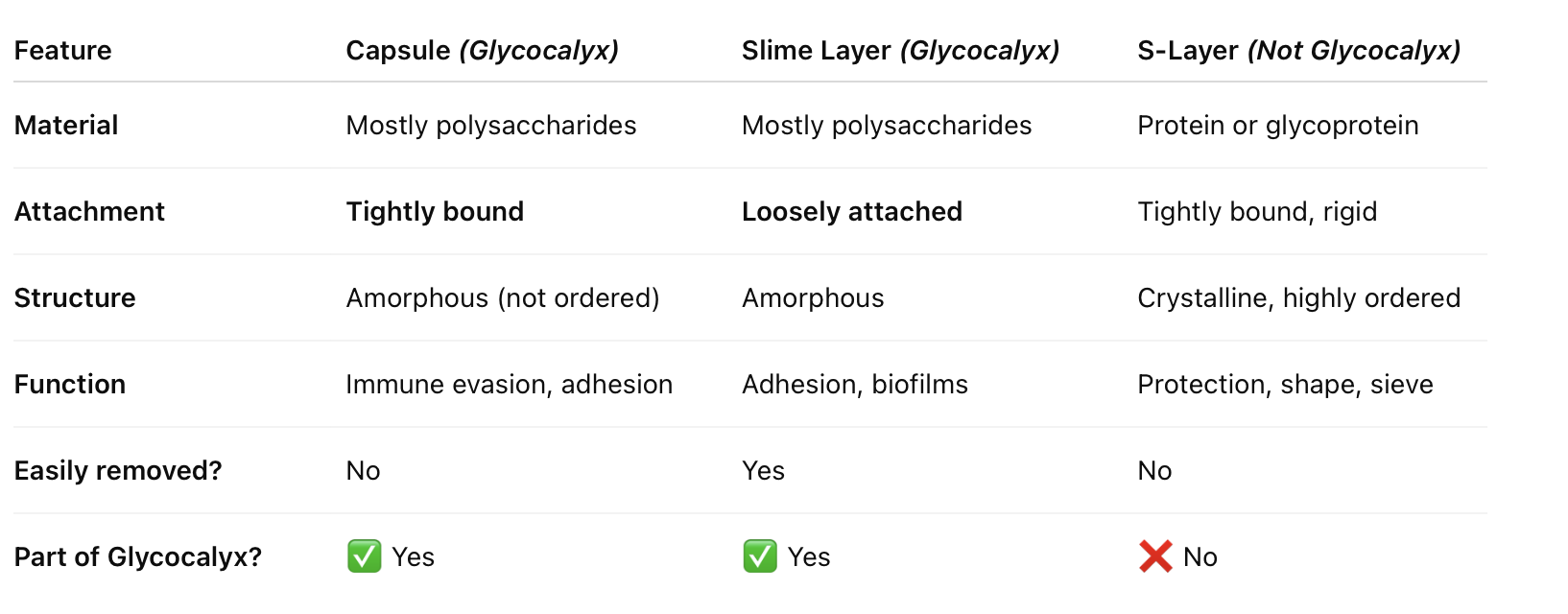
S-layers and some capsules are composed of proteins. Know how these differ.
S-layers and some capsules are both composed of protein, but they differ in structure and function.
S-layers are crystalline arrays found on the surface of both Gram-positive and Gram-negative bacteria and can act as a protective shield against environmental stress. Unlike capsules, S-layers are more uniform and often involved in shape maintenance, pH regulation, and adhesion.
Capsules are typically more involved in immune evasion
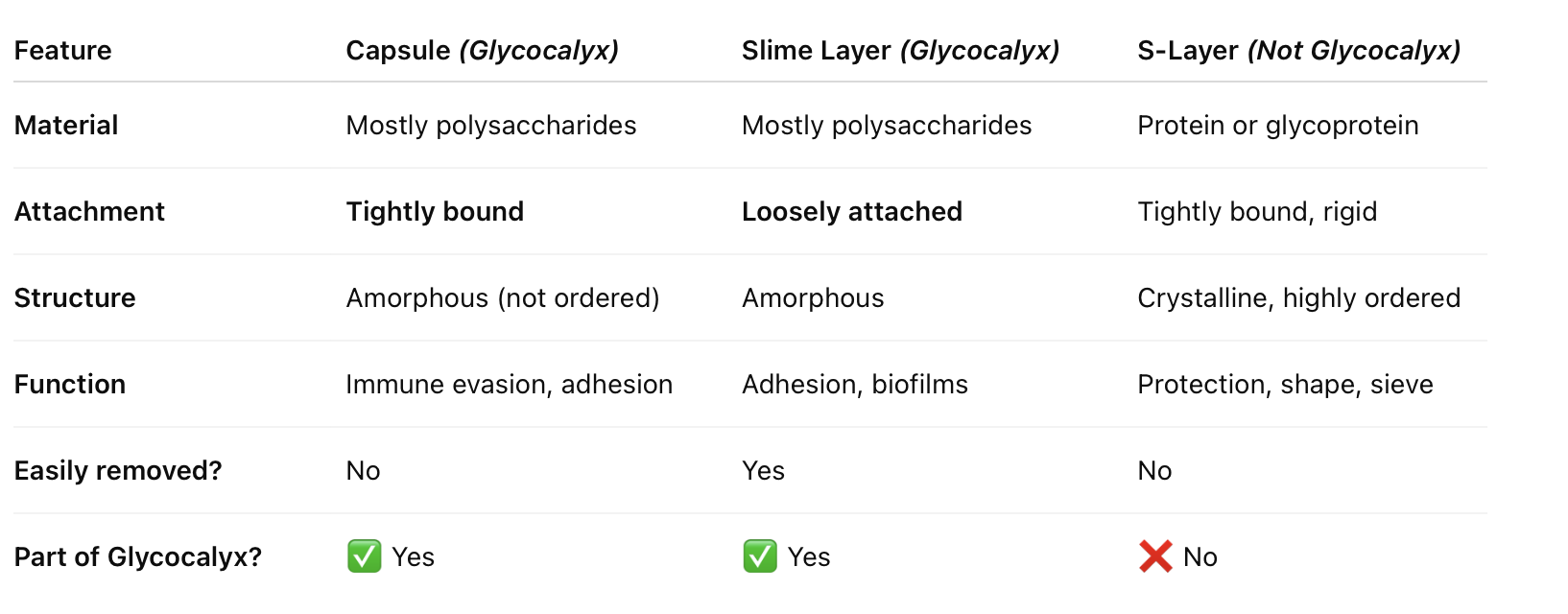
Know the different stages for bacterial growth and be able to describe them.
a. For example, the exponential phase is the most common target for antibacterial drug treatments. Give an example of an antibiotic that inhibits cell wall synthesis or inhibits protein synthesis and explain how it does it.
The bacterial growth curve has five stages: lag, exponential (log), stationary, death, and long-term stationary. The exponential phase is when cells actively divide and is the most common target for antibiotics.
For example, penicillin inhibits peptidoglycan synthesis, disrupting cell wall formation and leading to cell lysis. This is most effective during rapid growth when cell wall construction is continuous
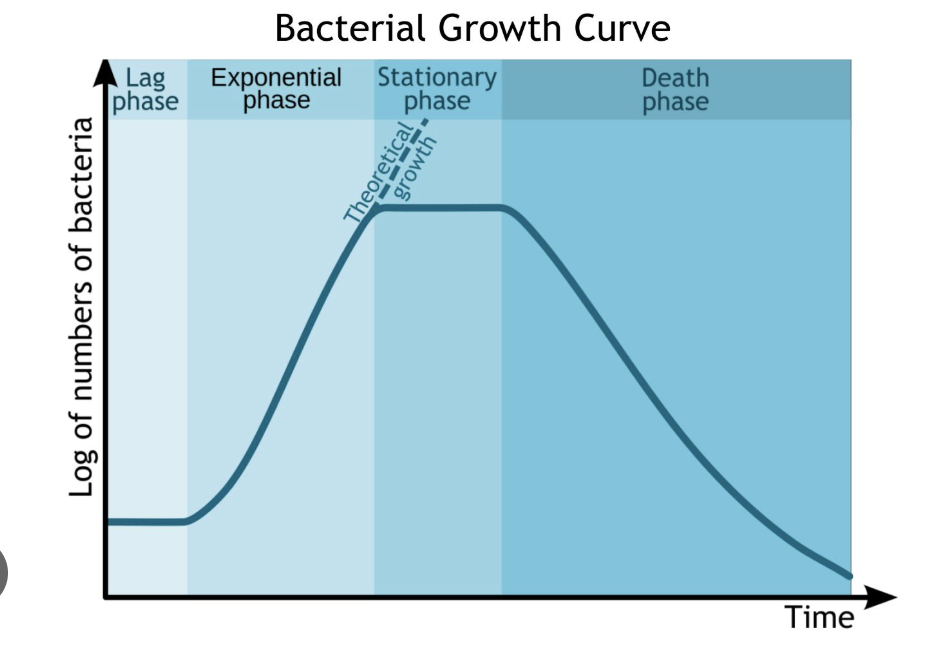
Know the different stages for bacterial growth and be able to describe them.
B. Another example how does the growth curve fluctuate when thinking about an oil spill and how different bacteria are found at different stages of oil breakdown. Be specific. (See Chap 5 Class Activity)
In the Deepwater Horizon oil spill, microbial succession followed the typical growth curve. Pseudomonas rapidly increased during the exponential phase, taking advantage of abundant simple hydrocarbons and oxygen for fast growth. As conditions changed, Methylomonas, which can use methane, became more prominent during the stationary phase, when resources became more specialized. Later, Saprospiraceae increased in abundance, likely thriving on more complex breakdown products and microbial debris—characteristic of the death or long-term stationary phase. This succession reflects how different bacteria dominate at different phases based on nutrient availability and environmental conditions.
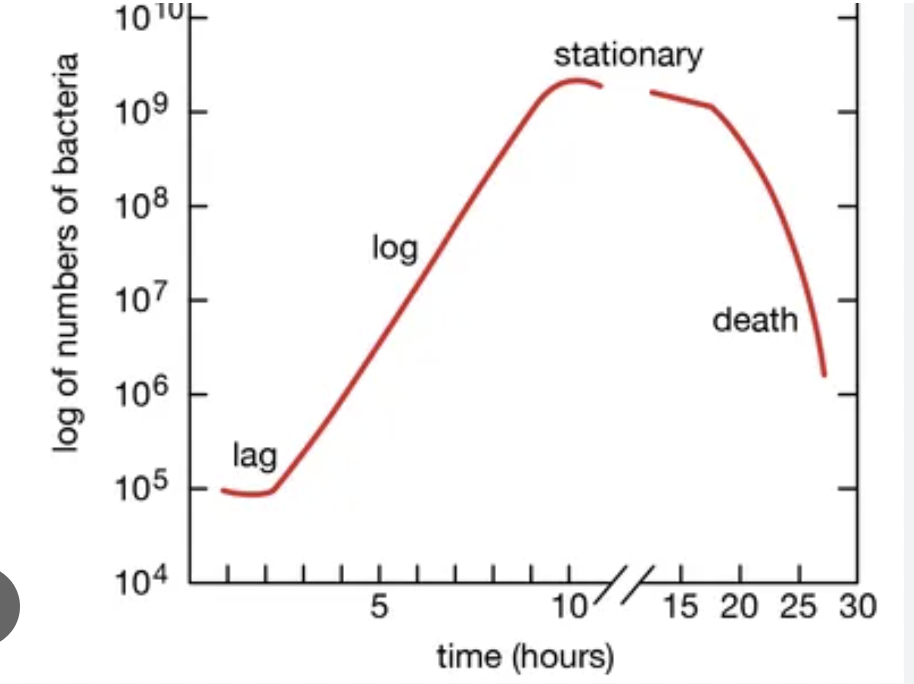
Know how the antibiotics we discussed can inhibit or kill bacterial cells.
Antibiotics can inhibit or kill bacteria through several mechanisms.
For example, beta-lactams like penicillin prevent cell wall synthesis by inhibiting transpeptidases.
Tetracyclines and aminoglycosides interfere with protein synthesis by targeting the 30S ribosomal subunit. Others disrupt DNA replication, membrane integrity, or metabolic pathways. These drugs exploit differences between bacterial and host cells for selective toxicity
Know the glycolytic pathways, EMP, EDP AND PPP. Be able to explain the steps and proteins along with inputs and outputs. (see Chap 6-7 Class Activity key to help you).
The EMP pathway (glycolysis) is the most common, breaking down glucose into pyruvate with a net gain of 2 ATP and 2 NADH.
The EDP is found in some Gram-negative bacteria and produces 1 ATP, 1 NADH, and 1 NADPH.
The PPP is mainly anabolic, generating NADPH and ribose-5-phosphate for biosynthesis. Each pathway serves distinct roles based on the cell’s metabolic needs
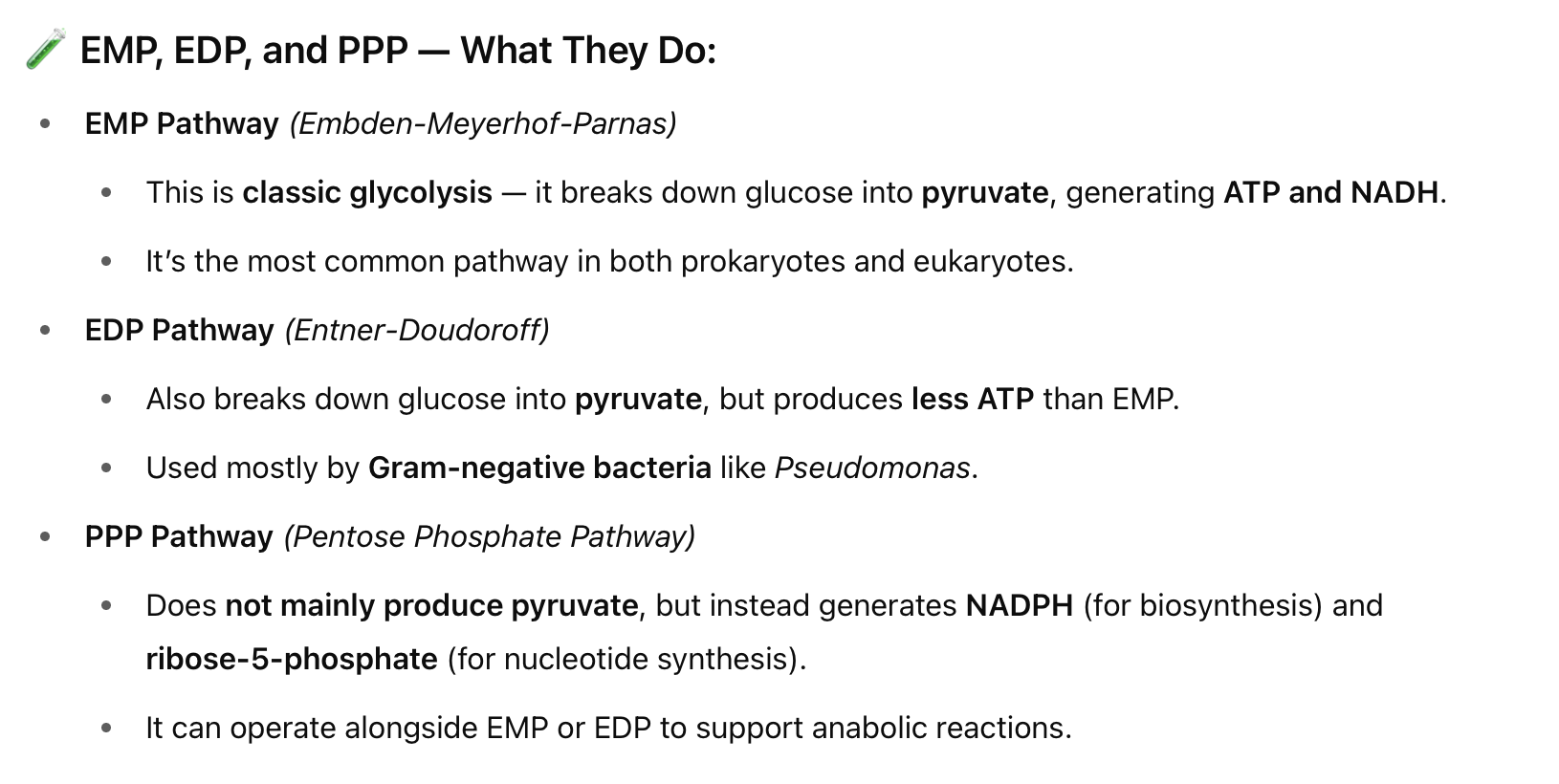
Describe binary fission in bacteria. Be sure to highlight each step in order.
Cell elongation – The cell grows and increases in volume.
DNA replication – The circular chromosome is duplicated starting at the origin of replication.
Chromosome segregation – The two chromosomes are separated and move to opposite poles.
Z-ring formation – The FtsZ protein assembles into a ring at the future site of division.
Septum formation – The divisome builds the division septum (new cell wall and membrane).
Cytokinesis – The cell splits into two genetically identical daughter cells.
Know how termination of replication in E. coli differs from replication of linear
chromosomes in B. burgdorferi bacteria.
E. coli has a circular chromosome with a single origin of replication and uses the replisome for bidirectional DNA synthesis. Termination occurs at a defined ter site, with Tus proteins helping to stop the replication forks.
In contrast, Borrelia burgdorferi has a linear chromosome with telomere-like structures at the ends. This structural difference alters how replication is terminated and processed
What is Quorum sensing? How do microorganisms communicate to each other. Describe benefits to different organisms that utilize quorum sensing.
Quorum sensing is a form of bacterial communication that depends on population density. Bacteria release signaling molecules like AHLs or peptides, which increase in concentration as the population grows. When a threshold is reached, it triggers coordinated gene expression—such as biofilm formation, bioluminescence, or virulence factor production. This allows the bacterial community to act collectively in response to environmental cues.
Discuss the three stages of CRISPR/Cas System. Name each stage and briefly describe what each stage does.
The CRISPR-Cas system is a bacterial immune defense with three stages: Adaptation, Expression, and Interference.
In adaptation, foreign DNA is integrated into the CRISPR array as new spacers.
During expression, the array is transcribed and processed into crRNAs.
In interference, crRNAs guide Cas proteins to recognize and cleave matching foreign DNA, protecting the cell from future attacks.
Be able to compare transduction, transformation, and conjugation. Give specific examples for each one.
Transformation involves uptake of free DNA from the environment (e.g., Streptococcus pneumoniae).
Transduction uses bacteriophages to transfer DNA between bacteria, such as phage λ in E. coli.
Conjugation requires direct contact via a pilus to transfer plasmids, like the F plasmid in E. coli. These horizontal gene transfer mechanisms increase genetic diversity and adaptability
Compare and contrast the presence of sugar (lactose or arabinose) versus the amino acid tryptophan. Be specific about what is inhibited and how they do it.
In sugar-based operons like lac or ara, the presence of sugar turns the operon on by inactivating a repressor or activating an activator protein.
In contrast, the trp operon is repressible and turned off when tryptophan is abundant, as the corepressor binds the repressor to block transcription. These systems illustrate different modes of negative feedback regulation in bacteria.
Discuss Bacterial conjugation and what happens during mating. (be sure to include F+, F-, F’, and Hfr)
During conjugation, an F+ cell (donor) transfers the F plasmid to an F– cell (recipient), making it F+. An Hfr cell has the F plasmid integrated into its chromosome and may transfer chromosomal genes during mating. If excision is imperfect, the F plasmid carries chromosomal DNA, creating an F′ plasmid. These mechanisms contribute to horizontal gene transfer and genetic variation.
Review the Human Microbiome article and the question from the class activity. (Chap 24 Class Activity)
The human microbiome includes all the microorganisms that live on and within the body and plays vital roles in digestion, immune development, and disease resistance. Environmental changes, such as pollution and overuse of fertilizers, reduce soil microbial diversity, which in turn lowers the nutrient content of crops.
Consuming nutrient-poor food can disrupt gut microbial balance—reducing beneficial bacteria like Bacteroides and increasing harmful ones like Proteobacteria. This imbalance, or dysbiosis, affects immune responses, gut health, and may contribute to chronic disease. Human activity can therefore indirectly shape our microbiomes through changes in environmental microbial ecosystems.